胡壮麟语言学教程课件Part12
语言学精品课胡壮麟版ppt课件
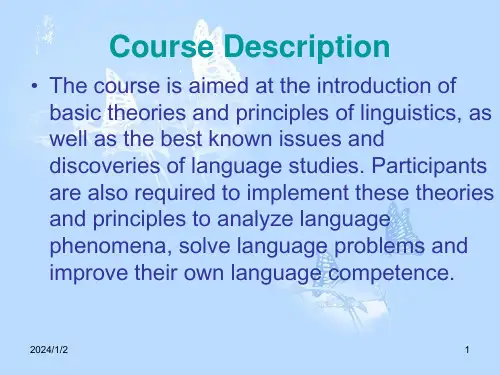
2. Scopes of linguistics
☺General linguistics—studies linguistics as a whole.
☺ Phonetics—study of sounds ☺ Phonology--study of the system of
sounds, how they are combined ☺ Morphology—study of the structure and
language development, more practical than written form, hard to record • writing : • permanent, can be recorded
• ngue and parole • —by the Swiss linguist F. de Saussure
• descriptive –describes and analyzes the language people are currently speaking. It deals with “what people actually say”
• 3.2 synchronic vs. diachronic • synchronic—description of a language at
• 2.1.4. Language is symbolic. • 2.1.5. Language is human –specific. • 2.1.6. Language is used for
communication
2.2. Design features of language
• 2.2.1. arbitrariness • 2.2.2. productivity • 2.2.3. duality • 2.2.4. displacement • 2.2.5. cultural transmission
胡壮麟《语言学教程》第三版语音学Phonetics课件.ppt
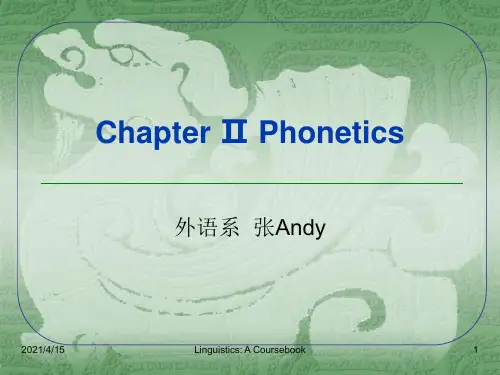
2021/4/15
Linguistics: A Coursebook
8
4.3 Coarticulation
Coarticulation: the influence on a sound by its
neighbors e.g. cap [kap]
f v θ ð s z ∫3
h
Approxi w mant
r
j
Lateral
l
Affricate
t∫ d3
Table 1 A chart of English consonants
2021/4/15
Linguistics: A Coursebook
11
5.3 Classification of vowels
2021/4/15
Linguistics: A Coursebook
9
5. Phonetic Classification
Vowels and consonants Classification of consonants Classification of vowels
2021/4/15
Linguistics: A Coursebook
2021/4/15
Linguistics: A Coursebook
6
4.1 Segment and divergence
Segment: any linguistic unit in a sequence which may be isolated from the rest of the sequence, e.g. a sound in an utterance or a letter in a written text. (Feasibility)
胡壮麟《语言学教程》笔记第12章
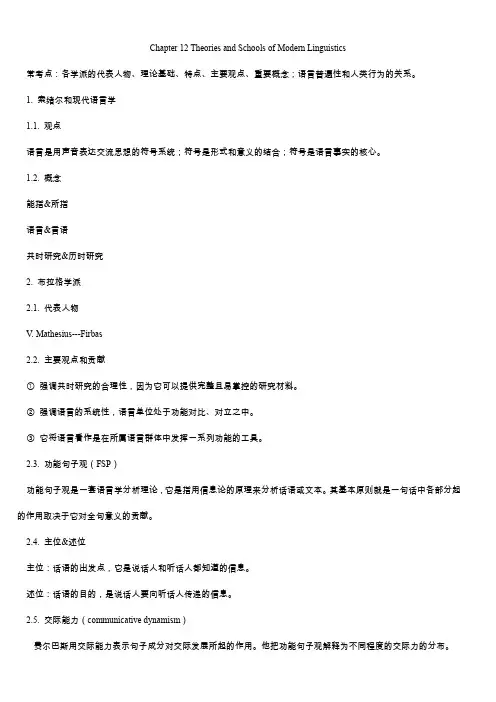
Chapter 12 Theories and Schools of Modern Linguistics常考点:各学派的代表人物、理论基础、特点、主要观点、重要概念;语言普遍性和人类行为的关系。
1. 索绪尔和现代语言学1.1. 观点语言是用声音表达交流思想的符号系统;符号是形式和意义的结合;符号是语言事实的核心。
1.2. 概念能指&所指语言&言语共时研究&历时研究2. 布拉格学派2.1. 代表人物V. Mathesius---Firbas2.2. 主要观点和贡献①强调共时研究的合理性,因为它可以提供完整且易掌控的研究材料。
②强调语言的系统性,语言单位处于功能对比、对立之中。
③它将语言看作是在所属语言群体中发挥一系列功能的工具。
2.3. 功能句子观(FSP)功能句子观是一套语言学分析理论,它是指用信息论的原理来分析话语或文本。
其基本原则就是一句话中各部分起的作用取决于它对全句意义的贡献。
2.4. 主位&述位主位:话语的出发点,它是说话人和听话人都知道的信息。
述位:话语的目的,是说话人要向听话人传递的信息。
2.5. 交际能力(communicative dynamism)费尔巴斯用交际能力表示句子成分对交际发展所起的作用。
他把功能句子观解释为不同程度的交际力的分布。
3. 伦敦学派3.1. 代表人物B. Malinovski---Firth---M. A. K. Halliday3.2. B. Malinovski 的理论①语言是一种行为模式。
②话语意义来源于话语发生的上下义之间的关系。
3.3. Firth的理论弗斯认为语言是种社会过程。
语言是参与社会生活的工具,是自己做事和使他人做事的手段,是一种行为和生活手段。
3.4. M. A. K. Halliday与系统-功能语法韩礼德的系统-功能语法是一种具有社会学倾向的功能语言学方法。
①系统语法系统就是存在于语法中的一系列选择。
胡壮麟语言学chapter12(名牌大学教授整理)PPT课件
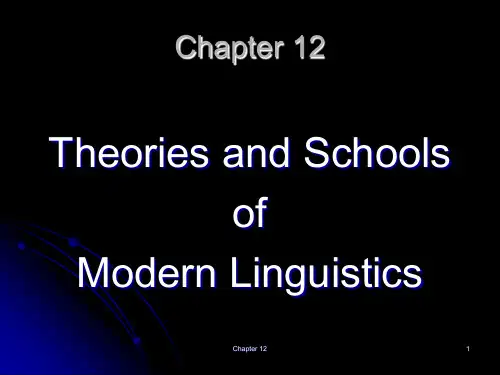
Sechehaye, collected lecture notes
from students and put them together
to produce the great work, Course in
General Linguistics, in 1916.
Chapter 12
4
Birth of Modern Linguistics
This book became the most important source of Saussure's ideas and of his influence upon succeeding generations of linguists. Saussure's ideas were developed along three lines: linguistics, sociology, and psychology.
During the years between 1907 to
1911, Saussure lectured on general
linguistics in the University of
Geneva. After he died in 1913, two of
his students, C. Bally and A.
called the signifier (能指) and the
signified (所指).ChapteFra bibliotek 127
Birth of Modern Linguistics (3) Saussure’s ideas on the arbitrary nature of sign, on the relational nature of linguistic units, on the distinction of LANGUE and PAROLE and of SYNCHRONIC and DIACHRONIC linguistics, etc. pushed linguistics into a brand new stage.
胡壮麟语言学课件

2. What is this course about?Chapter 1 Invitations to LinguisticsChapter 2 Speech SoundsChapter 3 LexiconChapter 4 SyntaxChapter 5 MeaningChapter 6 Language and cognitionChapter 7 Language, Culture, and SocietyChapter 8 Language in useChapter 9 language and literatureChapter 10 language and computerChapter 11 linguistics and foreign language teachingChapter 12 Theories and schools of modern linguistics1. languageDefinitionFeaturesFunctions1) Definition:Sapir, 1921: Language is a purely human and non-instinctive method of communicating ideas, emotions and desires by means of voluntarily produced symbols.(语言是纯粹人为的、非本能的、用任意制造出来的符号系统来传达观念、情绪和欲望的方法。
)Hall, 1968: Language is "the institution whereby humans communicate and interact with each other by means of habitually used oral-auditory arbitrary symbols." (语言是人们通过惯用的任意性的口头-听觉符号进行交际和互动的惯例。
英语语言学胡壮麟12Chapter 12_schools
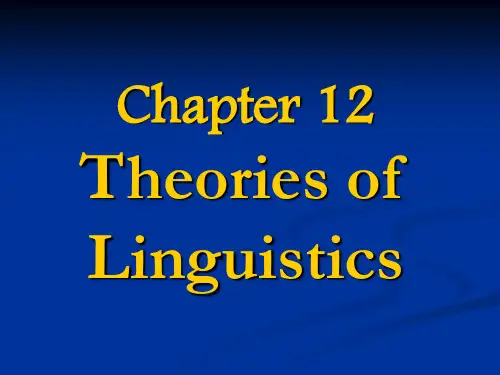
2. The functional perspective
Thechool
1.1 The Prague School
Prague Linguistic Circle:
Started by V. Mathesius (1882-1946) in 1926, with such activists as R. Jacobson (1896-1982), N. Trubetzkoy (1890-1938) and later J. Firbas (1921-2000). The Circle stood at the heart of important developments in structural linguistics and semiotics in the 1930's.
Langue VS Parole Langue collective abstract system shared by a community Parole actual speech made by an individual Structural linguistics is more interested in the LANGUE than in any parole.
Synchronic VS Diachronic Synchronic study of a system as it exists at one moment in time Diachronic study of a system over a specific extent of time
vertical axis is the paradigmatic. the syntagmatic relations are possibilities of combination; while paradigamatic/associative relations are possibilities of selection. Syntagmatic relations are a product of linguistic structure; while paradigmatic relations are only choices in your head.
胡壮麟《语言学教程》
胡壮麟《语言学教程》(修订版)学习指导前言其实我的这一个语言学学习指导系列本来没有想做得这么大的,最初只是我买了一本语言学教程的辅导资料,发现里面有的名词解释总结得很不错,所以就想整理一下各章的名词解释。
后来觉得既然是整理,光整理名词解释,还不如对知识点做一个较全面的学习指导材料。
结果就此一发而不可收,终于形成了现在的这一整套资料。
不明白是什么的朋友们可以参考考研论坛外语版的相关帖子。
本资料主要分为三部分,第一部分为各章节提纲笔记,第二部分为重点章节测试题,第三部分为测试题参考答案。
整理这一套资料真得很劳心费力,希望能够对大家有所帮助。
在考研论坛上,我所有的相关资料都设置了阅读权限和K币,一个是为了防止盗用,但更重要的不是为了限制什么,只是希望大家在能够很容易得到资料的同时,也能够想到要付出一些,将来考上研了以后能够回到这里,与后来的研友们分享一些所能够得到的信息,资源共享,信息交流,这才是考研论坛的本意。
也希望大家在以后复习语言学的时候,能够想到冰暖茶在这门课程上作的小小的努力,如果大家都能成功,我的努力就是值得的。
需要说明的是,我在整理资料的过程中,得到了ksguobw, lxm1000w, micronannan, 天使精灵(排名不分先后)等朋友的资源共享和大力协助,在此对他们以及一贯支持冰暖茶的朋友们表示感谢!由于水平有限,加之时间仓促,疏漏之处在所难免,欢迎各位读者批评指正。
冰暖茶2006年11月目录前言 (1)目录 (3)第一部分各章节提纲笔记 (4)Chapter 1 Invitations to Linguistics (4)Chapter 2 Speech Sounds (8)Chapter 3 Lexicon………………………………………………………………………………14Chapter 4 Syntax………………………………………………………………………………21Chapter 5 Meaning (26)Chapter 6 Language Processing in Mind………………………………………………………29Chapter 7 Language, Culture and Society………………………………………………………35Chapter 8 Language in Use (38)Chapter 9 Language and Literature (44)Chapter 10 Language and Computer……………………………………………………………49Chapter 11 Linguistics and Foreign Language Teaching………………………………………53Chapter 12 Theories and Schools of Modern Linguist ics………………………………………59第二部分重点章节测试题……………………………………………………………………67Test One Invitations to Linguistics (67)Test Two Phonetics and Phonology……………………………………………………………70Test Three Morphology…………………………………………………………………………73Test Four Syntax (76)Test Five Semantics……………………………………………………………………………79Test Six Pragmatics (82)Test Seven Language, Culture and Society (85)Test Eight Theor ies and Schools of Modern Linguistics………………………………………88第三部分测试题参考答案……………………………………………………………………91参考书目 (100)第一部分各章节提纲笔记Chapter 1 Invitations to Linguistics1.1 Why study language?1. Language is very essential to human beings.2. In language there are many things we should know.3. For further understanding, we need to study language scientifically.1.2 What is language?Language is a means of verbal communication. It is a system of arbitrary vocal symbols used for human communication.1.3 Design features of languageThe features that define our human languages can be called design features which can distinguish human language from any animal system of communication.1.3.1 ArbitrarinessArbitrariness refers to the fact that the forms of linguistic signs bear no natural relationship totheir meanings.1.3.2 DualityDuality refers to the property of having two levels of structures, such that units of the primary level are composed of elements of the secondary level and each of the two levels has its own principles of organization.1.3.3 CreativityCreativity means that language is resourceful because of its duality and its recursiveness. Recursiveness refers to the rule which can be applied repeatedly without any definite limit. The recursive nature of language provides a theoretical basis for the possibility of creating endless sentences.1.3.4 DisplacementDisplacement means that human languages enable their users to symbolize objects, events and concepts which are not present (in time and space) at the moment of conversation.1.4 Origin of language1. The bow-wow theoryIn primitive times people imitated the sounds of the animal calls in the wild environment they lived and speech developed from that.2. The pooh-pooh theoryIn the hard life of our primitive ancestors, they utter instinctive sounds of pains, anger and joy which gradually developed into language.3. The “yo-he-ho” theoryAs primitive people worked together, they produced some rhythmic grunts which gradually developed into chants and then into language.1.5 Functions of languageAs is proposed by Jacobson, language has six functions:1. Referential: to convey message and information;2. Poetic: to indulge in language for its own sake;3. Emotive: to express attitudes, feelings and emotions;4. Conative: to persuade and influence others through commands and entreaties;5. Phatic: to establish communion with others;6. Metalingual: to clear up intentions, words and meanings.Halliday (1994) proposes a theory of metafunctions of language. It means that language has three metafunctions:1. Ideational function: to convey new information, to communicate a content that is unknown to the hearer;2. Interpersonal function: embodying all use of language to express social and personal relationships;3. Textual function: referring to the fact that language has mechanisms to make any stretch of spoken and written discourse into a coherent and unified text and make a living passage different from a random list of sentences.According to Hu Zhuanglin, language has at least seven functions:1.5.1 InformativeThe informative function means language is the instrument of thought and people often use it to communicate new information.1.5.2 Interpersonal functionThe interpersonal function means people can use language to establish and maintain their status in a society.1.5.3 PerformativeThe performative function of language is primarily to change the social status of persons, as in marriage ceremonies, the sentencing of criminals, the blessing of children, the naming of a ship at a launching ceremony, and the cursing of enemies.1.5.4 Emotive functionThe emotive function is one of the most powerful uses of language because it is so crucial in changing the emotional status of an audience for or against someone or something.1.5.5 Phatic communionThe phatic communion means people always use some small, seemingly meaningless expressions such as Good morning, God bless you, Nice day, etc., to maintain a comfortable relationship between people without any factual content.1.5.6 Recreational functionThe recreational function means people use language for the sheer joy of using it, such as a baby’s babbling or a chanter’s chanting.1.5.7 Metalingual functionThe metalingual function means people can use language to talk about itself. E.g. I can use the word “book” to talk about a book, and I can also use the expression “the word book” to talk about the sign “b-o-o-k” itself.1.6 What is linguistics?Linguistics is the scientific study of language. It studies not just one language of any one community, but the language of all human beings.1.7 Main branches of linguistics1.7.1 PhoneticsPhonetics is the study of speech sounds, it includes three main areas: articulatory phonetics, acoustic phonetics, and auditory phonetics.1.7.2 PhonologyPhonology studies the rules governing the structure, distribution, and sequencing of speech sounds and the shape of syllables.1.7.3 MorphologyMorphology studies the minimal units of meaning –morphemes and word-formation processes.1.7.4 SyntaxSyntax refers to the rules governing the way words are combined to form sentences in a language, or simply, the study of the formation of sentences.1.7.5 SemanticsSemantics examines how meaning is encoded in a language.1.7.6 PragmaticsPragmatics is the study of meaning in context.1.8 MacrolinguisticsMacrolinguistics is the study of language in all aspects, distinct from microlinguistics, which dealt solely with the formal aspect of language system.1.8.1 PsycholinguisticsPsycholinguistics investigates the interrelation of language and mind, in processing and producing utterances and in language acquisition for example.1.8.2 SociolinguisticsSociolinguistics is a term which covers a variety of different interests in language and society, including the language and the social characteristics of its users.1.8.3 Anthropological linguisticsAnthropological linguistics studies the relationship between language and culture in a community.1.8.4 Computational linguisticsComputational linguistics is an interdisciplinary field which centers around the use of computers to process or produce human language.1.9 Important distinctions in linguistics1.9.1 Descriptive vs. prescriptiveTo say that linguistics is a descriptive science is to say that the linguist tries to discover and record the rules to which the members of a language-community actually conform and does not seek to impose upon them other rules, or norms, of correctness.Prescriptive linguistics aims to lay down rules for the correct use of language and settle the disputes over usage once and for all.For example, “Don’t say X.” is a prescriptive command; “People don’t say X.” is a descriptive statement. The distinction lies in prescribing how things ought to be and describing how things are. In the 18th century, all the main European languages were studied prescriptively. However, modern linguistics is mostly descriptive because the nature of linguistics as a science determines its preoccupation with description instead of prescription.1.9.2 Synchronic vs. diachronicA synchronic study takes a fixed instant (usually at present) as its point of observation. Saussure’s diachronic description is the s tudy of a language through the course of its history. E.g.a study of the features of the English used in Shakespeare’s time would be synchronic, and a study of the changes English has undergone since then would be a diachronic study. In modern linguistics, synchronic study seems to enjoy priority over diachronic study. The reason is that unless the various state of a language are successfully studied it would be difficult to describe the changes that have taken place in its historical development.1.9.3 Langue & paroleSaussure distinguished the linguistic competence of the speaker and the actual phenomena or data of linguistics as langue and parole. Langue is relative stable and systematic, parole is subject to personal and situational constraints; langue is not spoken by an individual, parole is always a naturally occurring event. What a linguist should do, according to Saussure, is to draw rules from a mass of confused facts, i.e. to discover the regularities governing all instances of parole and make them the subject of linguistics.1.9.4 Competence and performanceAccording to Chomsky, a language user’s underlying knowledge about the system of rules is called the linguistic competence, and the actual use of language in concrete situations is called performance. Competence enables a speaker to produce and understand and indefinite number of sentences and to recognize grammatical mistakes and ambiguities. A speaker’s competence isstable while his performance is often influenced by psychological and social factors. So a speaker’s performance does not always match his supposed competence. Chomsky believes that linguists ought to study competence, rather than performance. Chomsky’s competence-performance distinction is not exactly the same as, though similar to, Saussure’s langue-parole distinction. Langue is a social product and a set of conventions of a community, while competence is deemed as a property of mind of each individual. Saussure looks at language more from a sociological or sociolinguistic point of view than Chomsky since the latter deals with his issues psychologically or psycholinguistically.1.9.5 Etic vs. emic[These two terms are still very vague to me. After I read Ji Daohong’s book, I can understand them better, bu t because they are vaguely mentioned in Hu’s book, it seems very difficult for me to understand them fully. – icywarmtea]Being etic means researchers’ making far too many, as well as behaviorally and inconsequential, differentiations, just as often the case with phonetics vs. phonemics analysis in linguistics proper.An emic set of speech acts and events must be one that is validated as meaningful via final resource to the native members of a speech community rather than via appeal to the investiga tor’s ingenuity or intuition alone.Following the suffix formations of (phon)etics vs (phon)emics, these terms were introduced into the social sciences by Kenneth Pike (1967) to denote the distinction between the material and functional study of language: phonetics studies the acoustically measurable and articulatorily definable immediate sound utterances, whereas phonemics analyzes the specific selection each language makes from that universal catalogue from a functional aspect.End of Chapter 1Chapter 2 Speech Sounds2.1 Speech production and perceptionPhonetics is the study of speech sounds. It includes three main areas:1. Articulatory phonetics – the study of the production of speech sounds2. Acoustic phonetics – the study of the physical properties of the sounds produced in speech3. Auditory phonetics – the study of perception of speech soundsMost phoneticians are interested in articulatory phonetics.2.2 Speech organsSpeech organs are those parts of the human body involved in the production of speech. The speech organs can be considered as consisting of three parts: the initiator of the air stream, the producer of voice and the resonating cavities.2.3 Segments, divergences, and phonetic transcription2.3.1 Segments and divergencesAs there are more sounds in English than its letters, each letter must represent more than one sound.2.3.2 Phonetic transcriptionInternational Phonetic Alphabet (IPA): the system of symbols for representing the pronunciation of words in any language according to the principles of the International Phonetic Association. The symbols consists of letters and diacritics. Some letters are taken from the Romanalphabet, some are special symbols.2.4 Consonants2.4.1 Consonants and vowelsA consonant is produced by constricting or obstructing the vocal tract at some places to divert, impede, or completely shut off the flow of air in the oral cavity.A vowel is produced without obstruction so no turbulence or a total stopping of the air can be perceived.2.4.2 ConsonantsThe categories of consonant are established on the basis of several factors. The most important of these factors are:1. the actual relationship between the articulators and thus the way in which the air passes through certain parts of the vocal tract (manner of articulation);2. where in the vocal tract there is approximation, narrowing, or the obstruction of the air (place of articulation).2.4.3 Manners of articulation1. Stop/plosive: A speech sound which is produced by stopping the air stream from the lungs and then suddenly releasing it. In English, [ ] are stops and [ ] are nasal stops.2. Fricative: A speech sound which is produced by allowing the air stream from the lungs to escape with friction. This is caused by bringing the two articulators, e.g. the upper teeth and the lower lip, close together but not closes enough to stop the airstreams completely. In English, [ ] are fricatives.3. (Median) approximant: An articulation in which one articulator is close to another, but without the vocal tract being narrowed to such an extent that a turbulent airstream is produced. In English this class of sounds includes [ ].4. Lateral (approximant): A speech sound which is produced by partially blocking the airstream from the lungs, usually by the tongue, but letting it escape at one or both sides of the blockage. [ ] is the only lateral in E nglish.Other consonantal articulations include trill, tap or flap, and affricate.2.4.4 Places of articulation1. Bilabial: A speech sound which is made with the two lips.2. Labiodental: A speech sound which is made with the lower lip and the upper front teeth.3. Dental: A speech sound which is made by the tongue tip or blade and the upper front teeth.4. Alveolar: A speech sound which is made with the tongue tip or blade and the alveolar ridge.5. Postalveolar: A speech sound which is made with the tongue tip and the back of the alveolar ridge.6. Retroflex: A speech sound which is made with the tongue tip or blade curled back so that the underside of the tongue tip or blade forms a stricture with the back of the alveolar ridge or the hard palate.7. Palatal: A speech sound which is made with the front of the tongue and the hard palate.8. Velar: A speech sound which is made with the back of the tongue and the soft palate.9. Uvular: A speech sound which is made with the back of the tongue and the uvula, the short projection of the soft tissue and muscle at the posterior end of the velum.10. Pharyngeal: A speech sound which is made with the root of the tongue and the walls ofthe pharynx.11. Glottal: A speech sound which is made with the two pieces of vocal folds pushed towards each other.2.4.5 The consonants of EnglishReceived Pronunciation (RP): The type of British Standard English pronunciation which has been regarded as the prestige variety and which shows no regional variation. It has often been popularly referred to as “BBC English” or “Oxford English” because it is widely used in the private sector of the education system and spoken by most newsreaders of the BBC network免费考研网。
胡壮麟《语言学教程》第三版语音学Phonetics课件.ppt
Monophthongs (pure vowels) and diphthongs (vowel glides)
Tongue rising: open (low), half-open (midlow), half-close (mid-high), close
2021/4/15
Linguistics: A Coursebook
3
2. Branches
The study falls into three main areas: articulatory phonetics, acoustic phonetics and auditory phonetics.
Chapter Ⅱ Phonetics
外语系 张Andy
2021/4/15
Linguistics: A Coursebook
1
Chapter Ⅱ Phonetics
1. Definition 2. Branches 3. Phonetic Description 4. Phonetic Transcription 5. Phonetic Classification
2021/4/15
Linguistics: A Coursebook
6
4.1 Segment and divergence
Segment: any linguistic unit in a sequence which may be isolated from the rest of the sequence, e.g. a sound in an utterance or a letter in a written text. (Feasibility)
Divergence: between sounds and symbols (necessity)
胡壮麟《语言学教程》笔记第12章.docx
精品文档Chapter 12 Theories and Schools of Modern Linguistics 常考点:各学派的代表人物、理论基础、特点、主要观点、重要概念;语言普遍性和人类行为的关系。
1.索绪尔和现代语言学1.1.观点语言是用声音表达交流思想的符号系统;符号是形式和意义的结合;符号是语言事实的核心。
1.2.概念能指 &所指语言 &言语共时研究 &历时研究2.布拉格学派2.1.代表人物V.Mathesius---Firbas2.2. 主要观点和贡献① 强调共时研究的合理性,因为它可以提供完整且易掌控的研究材料。
② 强调语言的系统性,语言单位处于功能对比、对立之中。
③ 它将语言看作是在所属语言群体中发挥一系列功能的工具。
2.3.功能句子观(FSP)功能句子观是一套语言学分析理论,它是指用信息论的原理来分析话语或文本。
其基本原则就是一句话中各部分起的作用取决于它对全句意义的贡献。
2.4.主位&述位主位:话语的出发点,它是说话人和听话人都知道的信息。
述位:话语的目的,是说话人要向听话人传递的信息。
1欢迎下载2.5.交际能力(communicative dynamism)费尔巴斯用交际能力表示句子成分对交际发展所起的作用。
他把功能句子观解释为不同程度的交际力的分布。
3.伦敦学派3.1.代表人物B. Malinovski---Firth---M. A. K. Halliday3.2. B. Malinovski的理论① 语言是一种行为模式。
② 话语意义来源于话语发生的上下义之间的关系。
3.3. Firth的理论弗斯认为语言是种社会过程。
语言是参与社会生活的工具,是自己做事和使他人做事的手段,是一种行为和生活手段。
3.4. M. A. K. Halliday与系统-功能语法韩礼德的系统 - 功能语法是一种具有社会学倾向的功能语言学方法。
①系统语法系统就是存在于语法中的一系列选择。
英语语言学及应用课件PPT胡壮麟史上最全面
2020/10/1
Contents
名词解释;学术流派对比评论;理论解释某语言现象 语料库语言学 、修辞学 、语用学 、认知语言学 、语言哲学 、 英汉对比语言学 、 语言学概论 语言学理论流派 流派漫谈:刘润清 认知语言学(附件) 第二语言习得(附件) 语料库语言学(附件)
2020/10/1
Or maybe the reason is in fact simple: human beings are always curious in seeking what they don’t know. Consider: What are taken for granted in our course of language use without realizing its wonder?
The distinction between vowels and consonants lies in the obstruction of airstream.
As there is no obstruction of air in the production of vowels, the description of the consonants and vowels cannot be done along the same lines.
tea 和 sea, /t/和/s/是两个不同的音位morpheme
What is the point of departure of phonology? A. phone B. sound C. voice D. phoneme
What is the point of departure of phonology? A. phone B. sound C. voice D. phoneme(音位)
- 1、下载文档前请自行甄别文档内容的完整性,平台不提供额外的编辑、内容补充、找答案等附加服务。
- 2、"仅部分预览"的文档,不可在线预览部分如存在完整性等问题,可反馈申请退款(可完整预览的文档不适用该条件!)。
- 3、如文档侵犯您的权益,请联系客服反馈,我们会尽快为您处理(人工客服工作时间:9:00-18:30)。
Literary linguistics studies the language of literature. It focuses on the study of linguistic features related to literary style.
9.1 Theoretical background
9.2.1 Foregrounding and grammatical form 9.2.2 Literal language and figurative language Simile
Metaphor
Metonymy
Synecdoche
9.2.3 The analysis of literary language
9.3.1 Sound patterning
9.3.2 Different forms of sound patterning
Rhyme
Alliteration
Assonance
Consonance
Reverse rhyme
Pararhyme
Repitition
-Metre(Dimetre, Trimetre, Tetrametre, Hexametre, Heptametre, Octametre)
-Foot (Iamb, Trochee, Anapest, Dactyl,Spondee, Pyrrhic)
9.3.4 Conventional forms of metre and sound Couplets
Quatrains
Blank verse
Sonnet
9.3.5 The poetic functions of sound and metre
9.3.6 How to analyse poetry?
9.4.1 Fictional prose and point of view
I-narrators: the person who tells the
story is a character in the fictional
world.
Third-person narrators: the narrator is not a character in the fictional world.
Schema-oriented language
Given vs New information
1) Speech presentation(Short)
Direct Speech(DS)
Indirect Speech (IDS)
Narrator’s Representation of Speech
Acts(NRSA)
Narrator’s Representation of Speech(NRS) Free Indirect Speech (FIS)
Speech presentation cline: NRS NRSA IS FIS DS
-Indirect Thought (IDT)
-Narrator’s Representation of Thought Acts(NRTA) -Narrator’s Representation of Thought(NRT)
-Free Indirect Thought (FIT)
-Stream of consciousness writing
9.4.3 Prose style
Authorial style
Text style
9.4.4 How to analyse the language of fiction?
9.5.1 How should we analyse drama? Drama as poetry
Drama as fiction
Drama as conversation
9.5.2 Analyzing dramatic language 9.5.3 How to analyse dramatic texts? Paraphrase the text
Write a commentary on the text Select a theoretical approach
1.What is the difference between direct thought and free indirect thought?
2.What is a speech presentation cline?。
